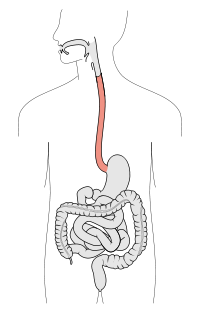
Photo from wikipedia
OBJECTIVE To determine whether muscle-sparing laryngoplasty results in fewer changes in swallowing function compared to standard surgical treatment for laryngeal paralysis. ANIMALS 12 clinically normal sexually intact male Beagles. PROCEDURES… Click to show full abstract
OBJECTIVE To determine whether muscle-sparing laryngoplasty results in fewer changes in swallowing function compared to standard surgical treatment for laryngeal paralysis. ANIMALS 12 clinically normal sexually intact male Beagles. PROCEDURES Group A dogs (n = 4) had a standard approach to the larynx, with left arytenoid cartilage lateralization. Group B dogs (n = 4) had a muscle-sparing laryngoplasty performed with the thyropharyngeus muscle fibers bluntly separated, and the cricoarytenoideus dorsalis muscle spared. Pre- and 24-hour postoperative fluoroscopic swallowing studies were performed and graded. Larynges were harvested after humane euthanasia, and glottic area was measured. Group C dogs (n = 4) acted as controls, with surgical dissection ending lateral to the thyropharyngeus muscle, arytenoid lateralization not performed, and the dogs not euthanized. The study was performed between October 15, 2011 and May 15, 2021. RESULTS Changes in pharyngeal and upper esophageal sphincter function were not detected in any group. There was no difference in glottic area between treatment groups. Aspiration of liquid was not a consistent finding. Two dogs in each treatment group developed moderate to severe cervical esophageal paresis. This did not occur in control dogs. CLINICAL RELEVANCE We found no evidence to support our hypothesis that muscle-sparing laryngoplasty results in less severe changes in swallowing function compared to a standard technique. The cervical esophageal paresis identified in both treatment groups could increase the risk of postoperative aspiration pneumonia in dogs treated for laryngeal paralysis via a lateral approach to the larynx. Further study to determine the frequency, cause, and duration of esophageal dysfunction is warranted.
Journal Title: American journal of veterinary research
Year Published: 2022
Link to full text (if available)
Share on Social Media: Sign Up to like & get
recommendations!